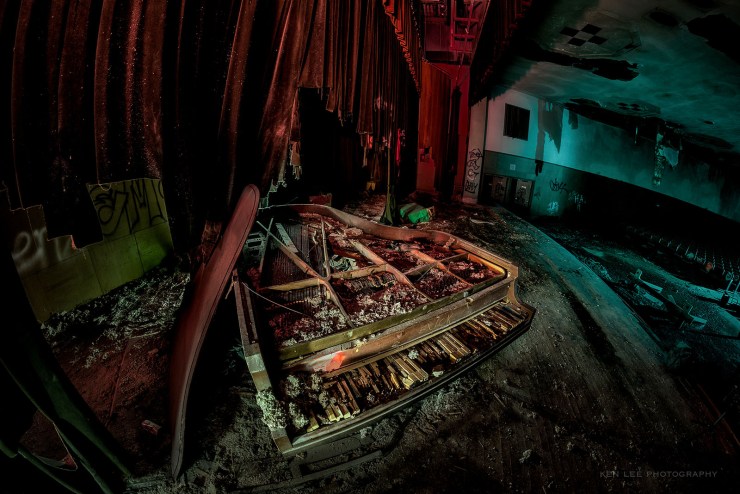We had just arrived at a creepy abandoned mental hospital on the East Coast. We walked through dystopian rooms with trees growing through the walls and windows. When we entered the large auditorium, I saw the piano on the stage. I knew instantly that I wanted to photograph it.
When we shined our flashlights around, it appeared as if it were snowing due to the advanced decay of the ceiling. We wore masks. You can see some of the “snow” in the photo.
Challenging aspects of this photo
Light painting this scene was challenging on numerous levels. One reason is that I used a Rokinon 12mm fisheye lens, which has a 180-degree view. It is challenging to not inadvertently shine the light directly into the lens and ruin the image.
Also, there was a lot going on in this photo, and making sure the piano was highlighted properly without being too distracting took some consideration.
Another challenge is that it was completely dark inside. And finally, it was very hot and humid, and this was compounded by wearing a stuffy N95 mask.

Four steps to light painting the abandoned piano
1. Creating texture on the piano
The piano could use some texture. I swept my handheld ProtoMachines LED2 over the top of the piano at an angle to accentuate the texture, keys, strings and general crud inside. I had to block the light from shining directly into the lens with my body.
2. Backlighting the heavy red curtains
I walked to the back of the stage, making sure not to trip over anything. Hiding in back of the curtains, I shined the light back toward the piano. This did two things. One, it backlit the red curtains, creating definition around the edges. Two, it also further illuminated the piano from the back, creating more illumination, but also more depth from the back strings.
It also made the first light a little less harsh, softening its effects. I then stood farther back and did the same thing so I could have the same effect on all the curtains.
3. Illuminating the stage
There was a lot of crud from the walls and ceiling on the stage. Holding the light low, I swept the floor to pick up some extra texture so it wouldn’t be completely black. This picked up the texture of the floor and debris. However, I still wanted the piano to be brighter and bolder, so I did just enough on the floor to accentuate the texture while still keeping it dark and shadowy and mysterious.
4. Creating the final touch
The crowning touch was to illuminate the seats where the audience once sat. To create separation, I used a green light, illuminating the seats and ceiling from camera right. I walked down the stairs to the seating area. I wanted an extreme angle so I would highlight the edges of the seats. I then walked back up the steps and swept the ceiling and back wall for good measure, also creating some shadows on the wall, just to add to an extra air of mystery and mood.
Why don’t I show up in the photo?
When I illuminated the interior, I walked through the frame — twice! Why didn’t I register? It’s because I walked quickly through an exposure that was several minutes long.
Generally, unless you inadvertently flash a light on yourself, you don’t begin to show up in a photo until you have been standing still for approximately 10 percent of the overall exposure! So yes, you can walk through the scene and not show up. Spooky, huh?
How would you have illuminated this? Would you have used different colors?
Tell your story with the second annual Visual Storytelling Conference!
Experience four days of interactive, online training sessions featuring a range of educational content with experienced photographers and content creators. This free event kicks off with a series of technical boot camps to build essential skills, followed by live, online sessions on photography, video, business and social media. Join live from March 10-13, 2022!
